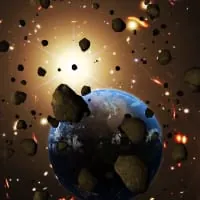
Earth May Have Had Its Own Spectacular Ring Like Saturn!
2024-09-26
Did you know that Earth could have once boasted an impressive ring system similar to Saturn? Recent research has unveiled startling evidence suggesting this celestial phenomenon might have existed around 466 million years ago! Get ready to have your mind blown as we dive into the possibility that our planet was once adorned with a magnificent ring!
The Astonishing Findings
A groundbreaking paper published in Earth and Planetary Science Letters has uncovered that during a period of intense meteorite impacts, Earth might have been encircled by a ring. This intriguing phenomenon could help clarify several mysteries regarding our planet's geological history.
About 466 million years ago, the Earth experienced an unusual spike in meteorite impacts, as evidenced by the formation of numerous craters in a short geological timeframe. Notably, sedimentary deposits rich in meteorite debris have been found in areas such as Europe, Russia, and China. Intriguingly, this debris showed signs of much shorter exposure to space radiation than contemporary meteorites, hinting at something extraordinary.
In conjunction with these meteorite activities, significant geological events like tsunamis occurred, leaving behind jumbled sedimentary rocks. Researchers are now piecing together a puzzle that links these events.
Decoding the Crater Pattern
The authors of the study meticulously examined 21 meteorite impact craters, assessing their geographical distribution. Remarkably, all craters emerged in areas near the equator during this time, with none appearing closer to the poles, a pattern that defies expectations.
Typically, meteorite impacts on Earth can happen at any latitude, as seen on the Moon and Mars, where craters populate diverse terrains. Thus, the concentration of craters around the equator raises significant questions. Curiously, only 30% of Earth's landmass suitable for preserving craters was near the equator, meaning the concentration of craters in this specific region is astronomically unlikely to be coincidental.
The leading hypothesis is that a large asteroid encountered Earth closely, causing it to fragment. For tens of millions of years, this asteroid's remnants could have rained down on Earth, explaining the patterning of craters, the sediment deposits, and the tsunamis identified.
Understanding Ring Formation
While Saturn's iconic rings are famous, our solar system features rings around other giants like Jupiter, Uranus, and Neptune. Moreover, some scientists suggest that Mars' small moons, Phobos and Deimos, may even be remnants of an ancient ring structure.
So how do these rings come into existence? When a small celestial body, such as an asteroid, meets a large planet like Earth, its gravitational pull can stretch and ultimately break the smaller body apart if it crosses a threshold known as the Roche limit. The debris from this collision can then form a ring, gradually migrating to occupy an orbital path along the planet's equatorial line.
If a similar event unfolded around Earth 466 million years ago, it could explain the unique distribution of impact craters, the meteorite debris in sedimentary rocks, and the tsunamis encountered during that epoch.
The Cooling Effect of a Potential Ring
Earth's continents were in vastly different configurations during this time due to continental drift, positioning many of them near the equator. The hypothetical ring would have cast a shadow on the planet's surface, potentially causing a significant cooling effect by blocking sunlight from reaching certain areas.
What’s even more astonishing is that around 465 million years ago, Earth began to cool significantly, culminating in the Hirnantian Ice Age, considered the coldest period in the past 500 million years! Could this ancient ring have played a role in the drastic temperature drop?
To unravel this intriguing conundrum, scientists plan to develop detailed mathematical models of asteroid break-up and the evolution of debris rings. Such simulations could reveal how much cooling might have been triggered by a ring and provide pivotal insights into Earth's climatic history.
Get ready for more mind-bending discoveries as scientists delve deeper into our planet’s enigmatic past! The idea that Earth could have once been surrounded by a ring system not only propels our understanding of planetary formations but also raises questions about the dynamic history of our solar system. Stay tuned!



 Brasil (PT)
Brasil (PT)
 Canada (EN)
Canada (EN)
 Chile (ES)
Chile (ES)
 España (ES)
España (ES)
 France (FR)
France (FR)
 Hong Kong (EN)
Hong Kong (EN)
 Italia (IT)
Italia (IT)
 日本 (JA)
日本 (JA)
 Magyarország (HU)
Magyarország (HU)
 Norge (NO)
Norge (NO)
 Polska (PL)
Polska (PL)
 Schweiz (DE)
Schweiz (DE)
 Singapore (EN)
Singapore (EN)
 Sverige (SV)
Sverige (SV)
 Suomi (FI)
Suomi (FI)
 Türkiye (TR)
Türkiye (TR)